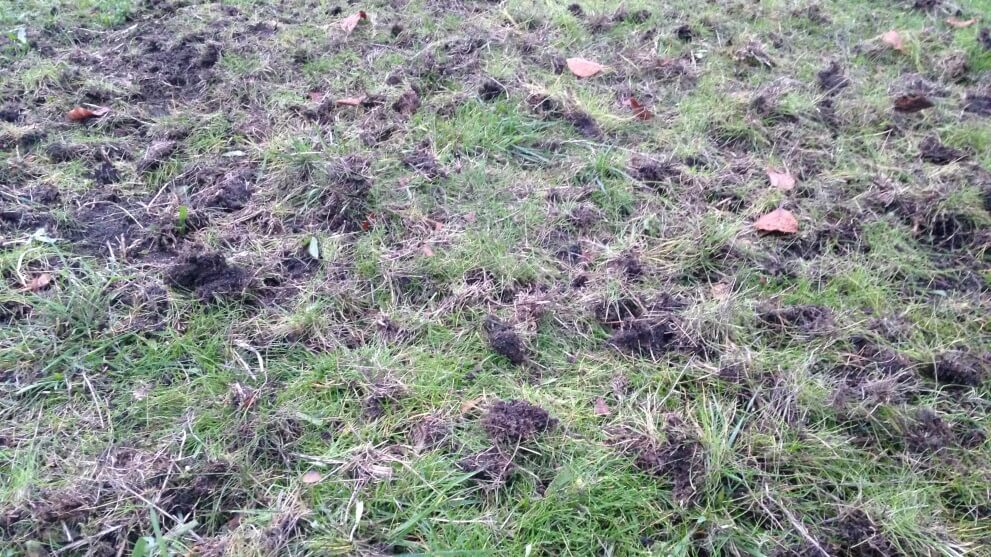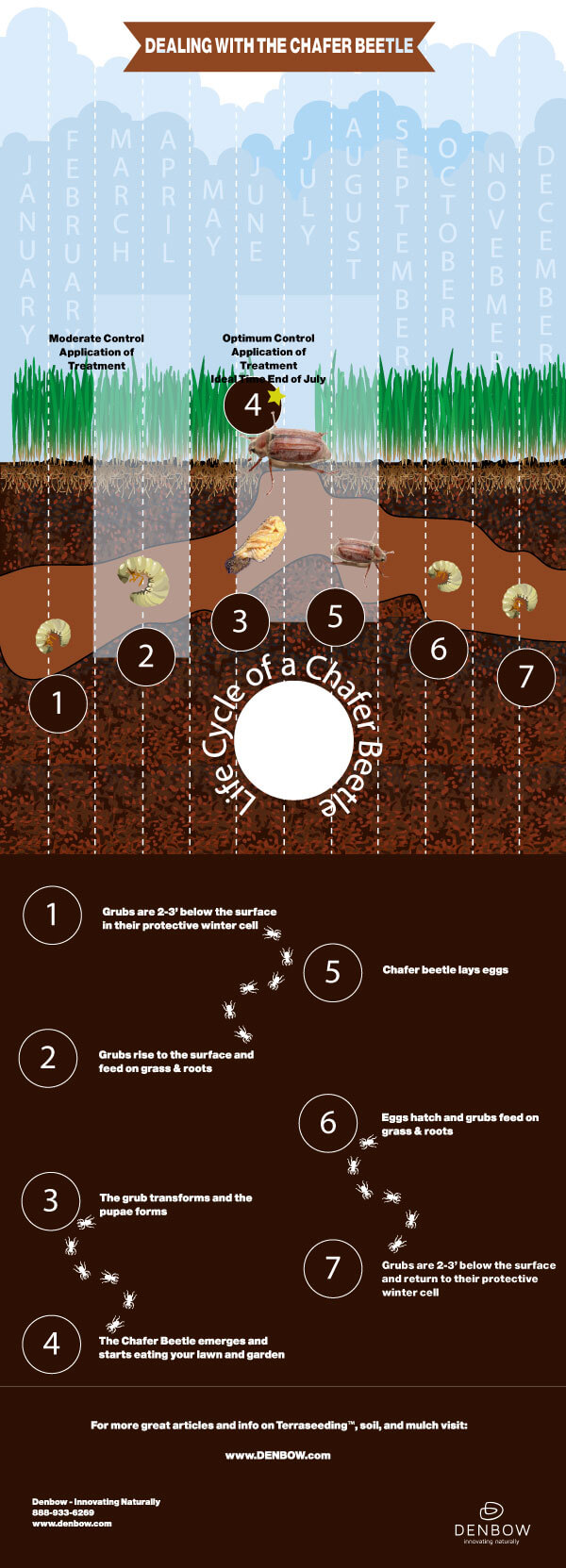
Crows and other animals may tear lawns apart seeking chafer beetle larvae. Photo: City of Surrey, BC.
Chafer beetles appear to be spreading in our region. We have recently gotten several comments in response to last year’s blog post about chafer beetles. People describe lawns that crows have ripped to shreds while looking for beetle larvae.
Here is more information about the chafer beetle’s life cycle. This will help you know what to do to defend your lawn against the beetle.
The European chafer beetle originated in continental Europe but is now an invasive species found in temperate climates in North America, where they are often called June bugs. The large grubs of the chafer feed on the roots of both wild and cultivated cool-latitude grasses, which has made them a critter-non-grata on North American lawns.
The chafer beetle’s life cycle
The chafer’s life cycle is one year. The imago (adult) stage is only 1–2 weeks long, with adult beetles growing to approximately 13–14 millimetres (0.51–0.55 in) in length. The adult chafers emerge from the ground in late spring and mate in large swarms, usually on shrubs and low trees.
They are most active on warm, clear nights when the temperature is over 19C (66F). The beetles come out of the ground at about 8:30 pm, mate through the night, and then return to the soil before the sun rises; they may return to the trees to mate again several times over the mating period.
Female chafer beetles lay between 20–40 eggs over their lifespan; the eggs are laid about 5–10 centimetres (2.0–3.9 in) deep in moist soil, and then take 2 weeks to hatch. The grubs hatch by late July. In frost zones, the grubs feed until November and then move deeper into the soil. In frost-free areas, however, the larva feed all winter.
Intense feeding occurs from March through May. Then, in early June, the grubs move deeper again, from 5 centimetres to 25 centimetres (2.0–9.8 in), where they form earthen cells and pupate. The pre-pupal stage lasts 2–4 days and the pupal stage lasts 2 weeks. By June, the new beetles begin emerging from the ground.
Beware other critters, too
Not only do the larvae feed on roots, wreaking havoc on lawns, but they attract local fauna like crows, foxes and raccoons, who dig up the grass in search of the grubs. So, in addition to root damage, homeowners also have to worry about destruction caused by larger creatures.
Why is it important to know about the life cycle of the chafer beetle?
Knowing the life cycle of the chafer beetle helps illustrate is when the beetle is most susceptible to treatment which will help exterminate the pest. The beetle’s most susceptible time is when it is the egg form in late July. Although treatment can help in early times in the season, July is the most optimal time to apply your treatment.
It’s also important to note that treatment should not be a one-time thing. In order to ensure the treatment and the extermination of the beetle, it is recommended to apply multiple treatments to your lawn or garden.
In Harmony does not recommend you apply any systemic insecticides or other chemicals. Even if the chemicals are “naturally” derived, they can kill worms and beneficial insects.
We do recommend beneficial nematodes and can apply them for you. Nematodes are tricky to use, however. Read our blog post for more information.
We hope you enjoy the article and download the infographic (at the bottom). If you liked it, please feel free to share!

Credit for the blog post and infographic go to Denbow, located in Chilliwack, BC.
Click on the pdf to download the infographic.

Thank you so much for this information. Right now we are in isolation in our home in AZ. We are extremely concerned about the Covid 19.
We have the June Bug in our Bothell houses lawn. I have seen the damage it makes.
We will be home in May, hopefully, and will discuss treatment with you at that time. Stay healthy and pray that this pandemic ends soon.
Thank you for your comment. We are all concerned about Covid-19. Please stay safe.
We would be happy to work with you to deal with the chafer beetle in your lawn. Contact us when you are back in Bothell.
Chafer beetle has destroyed my once immaculate lawn as it attracted raccoons and skunks. I’ve lived in this house in excess of 30 years never had a problem this year I signed up for gardening service am wondering if the bug/larva might have been transported from another unhealthy lawn. I was to late for July treatment and have applied Scott’s bug killer with no apparent success. Frustrating!
So sorry to hear about your problems with chafer beetle. It has not been in western Washington for long, so you would not have seen it anywhere until the last couple of years. I have not seen any research about how it spreads. It is possible it could be from a gardening service. It is also possible that the crows, raccoons and skunks are spreading it.
I don’t think the Scott’s bug killer would be helpful. There is some evidence that nematodes help, but they are tricky to apply. We have had some luck with Bug B Gone, which is a BT product (less hazardous than the Scott’s product). Read our June blog post for more info. https://inharmony.com/managing-chafer-beetles-what-to-do-in-june/